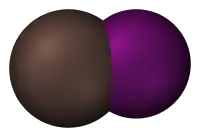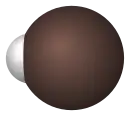Astatine compounds
Astatine compounds are compounds that contain the element astatine (At). As this element is very radioactive, few compounds have been studied. Less reactive than iodine, astatine is the least reactive of the halogens.[1] Its compounds have been synthesized in nano-scale amounts and studied as intensively as possible before their radioactive disintegration. The reactions involved have been typically tested with dilute solutions of astatine mixed with larger amounts of iodine. Acting as a carrier, the iodine ensures there is sufficient material for laboratory techniques (such as filtration and precipitation) to work.[2][3][lower-alpha 1] Like iodine, astatine has been shown to adopt odd-numbered oxidation states ranging from −1 to +7.
Only a few compounds with metals have been reported, in the form of astatides of sodium,[6] palladium, silver, thallium, and lead.[7] Some characteristic properties of silver and sodium astatide, and the other hypothetical alkali and alkaline earth astatides, have been estimated by extrapolation from other metal halides.[8]
The formation of an astatine compound with hydrogen – usually referred to as hydrogen astatide – was noted by the pioneers of astatine chemistry.[9] As mentioned, there are grounds for instead referring to this compound as astatine hydride. It is easily oxidized; acidification by dilute nitric acid gives the At0 or At+ forms, and the subsequent addition of silver(I) may only partially, at best, precipitate astatine as silver(I) astatide (AgAt). Iodine, in contrast, is not oxidized, and precipitates readily as silver(I) iodide.[10][11]
Astatine is known to bind to boron,[12] carbon, and nitrogen.[13] Various boron cage compounds have been prepared with At–B bonds, these being more stable than At–C bonds.[14] Astatine can replace a hydrogen atom in benzene to form astatobenzene C6H5At; this may be oxidized to C6H5AtCl2 by chlorine. By treating this compound with an alkaline solution of hypochlorite, C6H5AtO2 can be produced.[15] The dipyridine-astatine(I) cation, [At(C5H5N)2]+, forms ionic compounds with perchlorate[13] (a non-coordinating anion[16]) and with nitrate, [At(C5H5N)2]NO3.[13] This cation exists as a coordination complex in which two dative covalent bonds separately link the astatine(I) centre with each of the pyridine rings via their nitrogen atoms.[13]
With oxygen, there is evidence of the species AtO− and AtO+ in aqueous solution, formed by the reaction of astatine with an oxidant such as elemental bromine or (in the last case) by sodium persulfate in a solution of perchloric acid:[10][17] the latter species might also be protonated astatous acid, H
2AtO+
2.[18] The species previously thought to be AtO−
2 has since been determined to be AtO(OH)−
2, a hydrolysis product of AtO+ (another such hydrolysis product being AtOOH).[19] The well characterized AtO−
3 anion can be obtained by, for example, the oxidation of astatine with potassium hypochlorite in a solution of potassium hydroxide.[15][20] Preparation of lanthanum triastatate La(AtO3)3, following the oxidation of astatine by a hot Na2S2O8 solution, has been reported.[21] Further oxidation of AtO−
3, such as by xenon difluoride (in a hot alkaline solution) or periodate (in a neutral or alkaline solution), yields the perastatate ion AtO−
4; this is only stable in neutral or alkaline solutions.[22] Astatine is also thought to be capable of forming cations in salts with oxyanions such as iodate or dichromate; this is based on the observation that, in acidic solutions, monovalent or intermediate positive states of astatine coprecipitate with the insoluble salts of metal cations such as silver(I) iodate or thallium(I) dichromate.[15][23]
Astatine may form bonds to the other chalcogens; these include S7At+ and At(CSN)−
2 with sulfur, a coordination selenourea compound with selenium, and an astatine–tellurium colloid with tellurium.[24]

Astatine is known to react with its lighter homologs iodine, bromine, and chlorine in the vapor state; these reactions produce diatomic interhalogen compounds with formulas AtI, AtBr, and AtCl.[4] The first two compounds may also be produced in water – astatine reacts with iodine/iodide solution to form AtI, whereas AtBr requires (aside from astatine) an iodine/iodine monobromide/bromide solution. The excess of iodides or bromides may lead to AtBr−
2 and AtI−
2 ions,[4] or in a chloride solution, they may produce species like AtCl−
2 or AtBrCl−
via equilibrium reactions with the chlorides.[5] Oxidation of the element with dichromate (in nitric acid solution) showed that adding chloride turned the astatine into a molecule likely to be either AtCl or AtOCl. Similarly, AtOCl−
2 or AtCl−
2 may be produced.[4] The polyhalides PdAtI2, CsAtI2, TlAtI2,[25][26][27] and PbAtI[28] are known or presumed to have been precipitated. In a plasma ion source mass spectrometer, the ions [AtI]+, [AtBr]+, and [AtCl]+ have been formed by introducing lighter halogen vapors into a helium-filled cell containing astatine, supporting the existence of stable neutral molecules in the plasma ion state.[4] No astatine fluorides have been discovered yet. Their absence has been speculatively attributed to the extreme reactivity of such compounds, including the reaction of an initially formed fluoride with the walls of the glass container to form a non-volatile product.[lower-alpha 2] Thus, although the synthesis of an astatine fluoride is thought to be possible, it may require a liquid halogen fluoride solvent, as has already been used for the characterization of radon fluoride.[4][22]
Notes
- Iodine can act as a carrier despite it reacting with astatine in water because these reactions require iodide (I−), not (only) I2.[4][5]
- An initial attempt to fluoridate astatine using chlorine trifluoride resulted in formation of a product which became stuck to the glass. Chlorine monofluoride, chlorine, and tetrafluorosilane were formed. The authors called the effect "puzzling", admitting they had expected formation of a volatile fluoride.[29] Ten years later, the compound was predicted to be non-volatile, out of line with the other halogens but similar to radon fluoride;[30] by this time, the latter had been shown to be ionic.[31]
References
- Anders, E. (1959). "Technetium and astatine chemistry". Annual Review of Nuclear Science. 9: 203–220. Bibcode:1959ARNPS...9..203A. doi:10.1146/annurev.ns.09.120159.001223. (subscription required)
- Nefedov, V. D.; Norseev, Yu. V.; Toropova, M. A.; Khalkin, Vladimir A. (1968). "Astatine". Russian Chemical Reviews. 37 (2): 87–98. Bibcode:1968RuCRv..37...87N. doi:10.1070/RC1968v037n02ABEH001603. S2CID 250775410. (subscription required)
- Aten, A. H. W. Jr.; Doorgeest, T.; Hollstein, U.; Moeken, H. P. (1952). "Section 5: Radiochemical Methods. Analytical Chemistry of Astatine". Analyst. 77 (920): 774–777. Bibcode:1952Ana....77..774A. doi:10.1039/AN9527700774. (subscription required)
- Zuckerman & Hagen 1989, p. 31.
- Zuckerman & Hagen 1989, p. 38.
- Emsley, J. (2011). Nature's Building Blocks: An A-Z Guide to the Elements (New ed.). Oxford University Press. pp. 57–58. ISBN 978-0-19-960563-7.
- Kugler & Keller 1985, pp. 213–214.
- Kugler & Keller 1985, pp. 214–218.
- Kugler & Keller 1985, p. 211.
- Wiberg, N., ed. (2001). Holleman-Wiberg: Inorganic Chemistry. Translation of 101st German edition by M. Eagleson and W. D. Brewer, English language editor B. J. Aylett. Academic Press. p. 423. ISBN 978-0-12-352651-9.
- Kugler & Keller 1985, pp. 109–110, 129, 213.
- Davidson, M. (2000). Contemporary boron chemistry. Royal Society of Chemistry. p. 146. ISBN 978-0-85404-835-9.
- Zuckerman & Hagen 1989, p. 276.
- Elgqvist, J.; Hultborn, R.; Lindegren, S.; Palm, S. (2011). "Ovarian cancer: background and clinical perspectives". In Speer, S. (ed.). Targeted Radionuclide Therapy. Lippincott Williams & Wilkins. pp. 380–396 (383). ISBN 978-0-7817-9693-4.
- Zuckerman & Hagen 1989, pp. 190–191.
- Brookhart, M.; Grant, B.; Volpe, A. F. (1992). "[(3,5-(CF3)2C6H3)4B]-[H(OEt2)2]+: a convenient reagent for generation and stabilization of cationic, highly electrophilic organometallic complexes". Organometallics. 11 (11): 3920–3922. doi:10.1021/om00059a071.
- Kugler & Keller 1985, p. 111.
- Kugler & Keller 1985, p. 221.
- Sergentu, Dumitru-Claudiu; Teze, David; Sabatié-Gogova, Andréa; Alliot, Cyrille; Guo, Ning; Bassel, Fadel; Da Silva, Isidro; Deniaud, David; Maurice, Rémi; Champion, Julie; Galland, Nicolas; Montavon, Gilles (2016). "Advances on the Determination of the Astatine Pourbaix Diagram: Predomination of AtO(OH)2− over At− in Basic Conditions". Chem. Eur. J. 22 (9): 2964–71. doi:10.1002/chem.201504403. PMID 26773333.
- Kugler & Keller 1985, p. 222.
- Lavrukhina & Pozdnyakov 1970, p. 238.
- Kugler & Keller 1985, pp. 112, 192–193.
- Kugler & Keller 1985, p. 219.
- Zuckerman & Hagen 1989, pp. 192–193.
- Zuckerman & Hagen 1990, p. 212.
- Brinkman, G. A.; Aten, H. W. (1963). "Decomposition of Caesium Diiodo Astatate (I), (CsAtI2)". Radiochimica Acta. 2 (1): 48. doi:10.1524/ract.1963.2.1.48. S2CID 99398848.
- Zuckerman & Hagen 1990, p. 60.
- Zuckerman & Hagen 1989, p. 426.
- Appelman, E. H.; Sloth, E. N.; Studier, M. H. (1966). "Observation of Astatine Compounds by Time-of-Flight Mass Spectrometry". Inorganic Chemistry. 5 (5): 766–769. doi:10.1021/ic50039a016.
- Pitzer, K. S. (1975). "Fluorides of Radon and Element 118". Journal of the Chemical Society, Chemical Communications. 5 (18): 760b–761. doi:10.1039/C3975000760B.
- Bartlett, N.; Sladky, F. O. (1973). "The Chemistry of Krypton, Xenon and Radon". In Bailar, J. C.; Emeléus, H. J.; Nyholm, R.; et al. (eds.). Comprehensive Inorganic Chemistry. Vol. 1. Pergamon. pp. 213–330. ISBN 978-0-08-017275-0.
Works cited
- Kugler, H. K.; Keller, C. (1985). 'At, Astatine', System No. 8a. Gmelin Handbook of Inorganic and Organometallic Chemistry. Vol. 8 (8th ed.). Springer-Verlag. ISBN 978-3-540-93516-2.
- Lavrukhina, Avgusta Konstantinovna; Pozdnyakov, Aleksandr Aleksandrovich (1970). Analytical Chemistry of Technetium, Promethium, Astatine, and Francium. Translated by R. Kondor. Ann Arbor–Humphrey Science Publishers. ISBN 978-0-250-39923-9.
- Zuckerman, J. J.; Hagen, A. P. (1989). Inorganic Reactions and Methods, Volume 3, The Formation of Bonds to Halogens (Part 1). John Wiley & Sons. ISBN 978-0-471-18656-4.
- Zuckerman, J. J.; Hagen, A. P. (1990). Inorganic Reactions and Methods, Volume 4, The Formation of Bonds to Halogens (Part 2). John Wiley & Sons. ISBN 978-0-471-18657-1.
